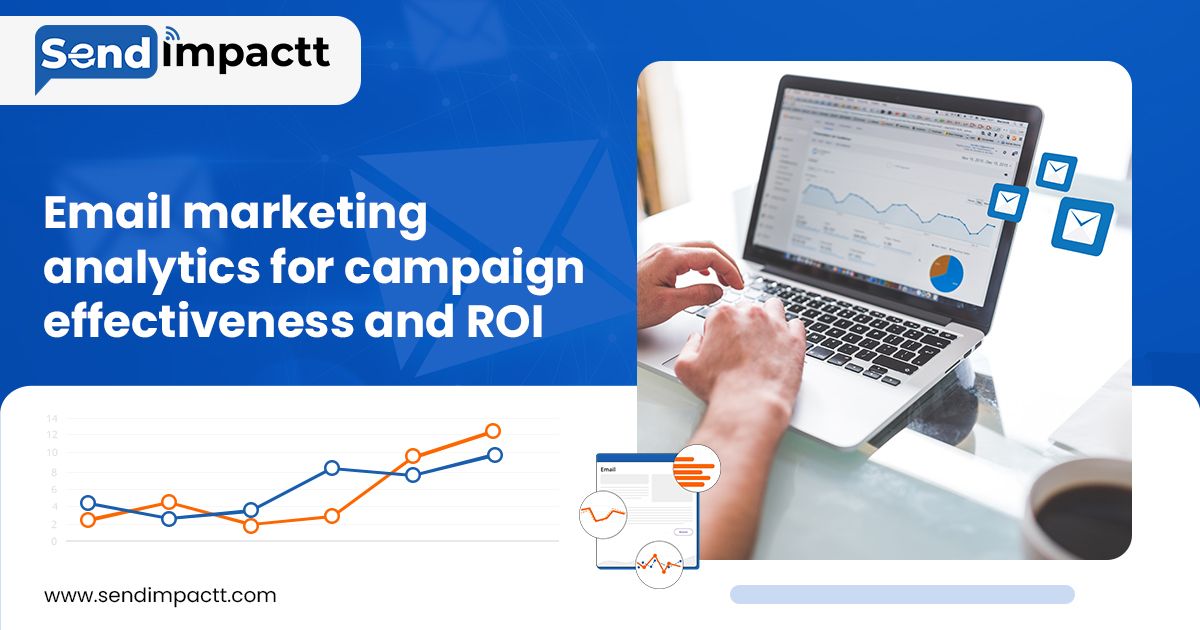Have you ever thought of gaining efficiency in your company’s email marketing campaigns in a moment of self-reflection? When it comes to the things that you are putting in, is your Return on Investment (ROI) best for the efforts that you are placing? Understanding the analytics behind best email marketing can let you peek into how the subsequent campaigns should be handled.
In the contemporary era of digital marketing, email is still widely used by businesses that target customers and know their revenues per investment. The specific details of the email marketing analytics can also create improvements in the strategies concerning the email campaigns and their ratios of effectiveness. The following are some of the ways through which analytics guarantees that marketing strategies function and are lucrative.
Understanding Email Marketing
Email marketing involves sending out messages to promote products or services or distributing newsletters to a selected clientele. This is a simple yet direct way of communicating with other members or prospective customers, promotion, and client interaction. For instance, right from the B2C marketers, to the small-scale marketers to the large marketing corporations, this mode of marketing remains a prominent cog in the wheel.
Key Metrics of Email Marketing
Open Rate
-
Definition:
This is the open rate of the number of people who consent to open the email.
-
Importance:
Illustrates how far the changes made to the subject line and the sender’s name would go in appealing to the recipients.
Click-Through Rate (CTR)
-
Definition:
The percentage of the recipients who clicked one or more of the links in the specific e-mail.
-
Importance:
The rate suggests the effectiveness of the text of the e-mail and the call to action.
Conversion Rate
-
Definition:
The proportion of the targets that clicked on the link to perform the intended purchase.
-
Importance:
Measures the campaign’s direct impact on revenue.
Bounce Rate
-
Definition:
This represents the ratios of total bouncers, which refers to emails that could not be delivered to the recipient’s inbox.
-
Importance:
Often, a high bounce rate may mean there is a problem with the email list quality and there might be technical problems too.
Unsubscribe Rate
-
Definition:
The total number of people who chose NOT to ALLOW emails in the future.
-
Importance:
Assists in determining the relevancy and frequency of the email content.
List Growth Rate
-
Definition:
The rate at which the email list is increasing.
-
Importance:
Provides information about the application and efficiency of lead generation, as well as list building.
Return on Investment (ROI) in Email Marketing
Studies have shown that email marketing has a high possibility of giving a good return on investment. The Direct Marketing Association has reported that even the simplest marketing has a $42 return on investment for every dollar spent. This makes email one of the strongest forms of marketing that can be used today as it is very cheap. In particular, the calculation of ROI can help organizations identify areas requiring an increase in investments or, on the contrary, reduce costs and improve the effectiveness of marketing strategies in general.
Calculating Email Marketing ROI
To calculate ROI, use the following formula:
For example, if you spend $2,000 on an email campaign and generate $10,000 in revenue, your ROI would be:
Statistics of Email Marketing
Indeed, email marketing is considered to be one of the most effective methods of addressing target audiences, but it remains unrivaled. Here are the recent Email Marketing statistics:

Content Distribution Statistics
- Emails with personalized content related to the recipient have 50% higher open rates.
- In regards to the role of email marketing, 80% of professionals are convinced that the process helps to acquire and retain customers.
Segmentation Statistics
- A segment e-mail campaign gets 30% higher open rates and 50% more clicks than those non-segmented campaigns.
- In regards to the role of email marketing, 80% of professionals are convinced that the process helps to acquire and retain customers.
Enhanced Customer Retention
- According to market statistics, more than half of the mailings are read on an unfamiliar device.
Customer Acquisition and Retention Statistics
- According to a report, email is 40 times better in the conversion rate of getting new business than both Meta and Twitter.
Automation Statistics
- Automatic emails have stimulated 21% of the email advertising revenue.
- Compared to non-automated, automated emails have an average open rate of around 41% open rates, 13% click rates, and 24% click-to-open rates.
- Automated emails can save up to 80% of your time and resources.
Personalization Statistics
- Dynamic subject tags yield 50% better results, as well as the number of users who open the received emails.
- 88% of users are more likely to respond to personalized emails that look like they are specially made for them.
- Marketer generated around 760% Revenue who segmented their audience before campaigning.
Email Conversion Rate Statistics
- They also found out that with an average conversion rate, marketing deploys a rate of 6.05%.
Email Frequency Statistics
- The ideal frequency of email communication with customers is 1–2 weak for most of the marketers.
Email Deliverability Stats
- Unfortunately, more often than not, around 72% of opt-in emails get delivered to the inbox.
- Around 6.3% of emails land in spam, 8% keep undelivered, and 14.3% of emails reach the intended inbox.
B2B Email Marketing Statistics
- B2B marketers get an average of 15.1% open rate, and a click-through rate should not be more than 3. 2%.
- 81% of B2B Marketers use newsletters in their email.
B2C Email Marketing Statistics
- A study shows that B2C marketers get an average open rate of 21% and for around 60% of the respondents marketing emails have influenced their purchases.
Ecommerce Marketing Statistics
- While the emails, which are connected to abandoned carts, have an average of 49.89% of the open rates.
- The purchase rate through email marketing is around 60%
Importance of Email Marketing Analytics
Email Marketing Analysis provides lots of details and important information about subscribers, the contents to be sent, and the effect on the campaign. Here’s why this mode of marketing analytics is indispensable:
-
Performance Measurement:
Some of the metrics include open rate, click-through rate (CTR), conversion rate, bounce rate, and unsubscribe rate. These metrics show to what degree the appeals of the campaign material are relevant to the target group of consumers. -
Audience Segmentation:
Detailed analytics allow segmentation based on demographics, behavior, purchase history, and more. Segmentation enables personalized messaging, enhancing relevance and engagement. -
Campaign Optimization:
Consequently, in the use of metrics, the regular characteristics of the published content, the time taken to issue the content, and the subject line are well identifiable by the marketers. This makes the strategies that are implemented to be more effective since the information is statistically analyzed to come up with better approaches. -
ROI Calculation:
Email marketing analytics provide concrete data toward the final consumers or the end-users, which is very effective in estimating the ROI, specifically down to statistics. The information on cost per lead or cost per conversion helps to provide accountabilities for expenses and plan the money spent.
Tips for Improving Campaign Effectiveness
Effective use of email marketing analytics involves more than just tracking numbers; it’s about deriving actionable insights to optimize future campaigns:
-
Segment Your Audience:
It’s important to note that special targeting of segments of your audience can increase the level of their activity with the tailored content.
-
A/B Testing:
Experiment with different subject lines, content, and call-to-actions to identify what resonates best with your audience.
-
Optimize for Mobile:
Finally, most of the emails are being opened through devices such as the mobile, thus the “Mobile-Friendly” should not be ignored if the business is to capture the potential taps.
-
Personalize Your Emails:
Use data to personalize your emails, from the subject line to the content, to make your emails more relevant to each recipient.
-
Lifecycle Analysis:
Track engagement rates based on subscription to the stage of purchasing, the loyal customer, aids in recommending the right content and promotions to the target audience thus increasing the lifetime customer value.
ROI Insights
Understanding the ROI of your email marketing efforts is crucial for optimizing your strategy. Here are some key insights:
- Investing in a robust marketing platform is essential for achieving sustainable ROI growth.
- It is worth remembering that, on balance, email marketing yields $ 42 of revenues per 1$ invested.
- Whenever these segmented campaigns are implemented by any firm, an update of between 760 percent of the increase in revenues is likely to be realized.
- Companies using segmented campaigns report as much as a 760% increase in revenue.
- When segmentation and targeting strategies have been well done, this will without doubt increase the return on investment implying that every people group is being presented with the right material.
- Automation reduces manual effort and ensures follow-ups, increasing possibilities of conversion and, hence, investment returns.
- Testing and optimizing email campaigns based on analytics can lead to continuous improvement in performance metrics like open rates and click-through rates.
Best Email Marketing Platform - Sendimpactt
When it comes to choosing the best email marketing platform, it can be said that the best option is the Sendimpactt service. From a powerful set of analytical tools to a convenient setting of the campaign, Sendimpactt creates an environment where businesses can manage and perform their marketing campaigns. For start-ups, small businesses, or any big enterprise, Sendimpactt precisely remodels its services according to the needs of the particular marketing campaign, guaranteeing the best ROI and influential results.
Conclusion
All in all, knowledge of analyzing marketing is critical for campaigns’ successful outcomes and owners’ return on investment. Email marketing statistics and other forms of analysis enable organizations to improve their approaches, increase sales, improve customer satisfaction, and gather tangible outcomes. Acquire the right tools and platforms like Sendimpactt to improve the efficiency of your marketing processes and achieve long-term company development with the best email marketing strategies.
Want to get the best email marketing? It is high time to begin using analytics and experience a new level of marketing results!
Discover the possibilities of effective the best email marketing with Email marketing statistics and expand your campaigns with the help of Send Impact. Visit us to know more.
